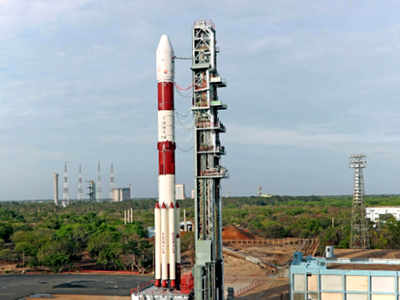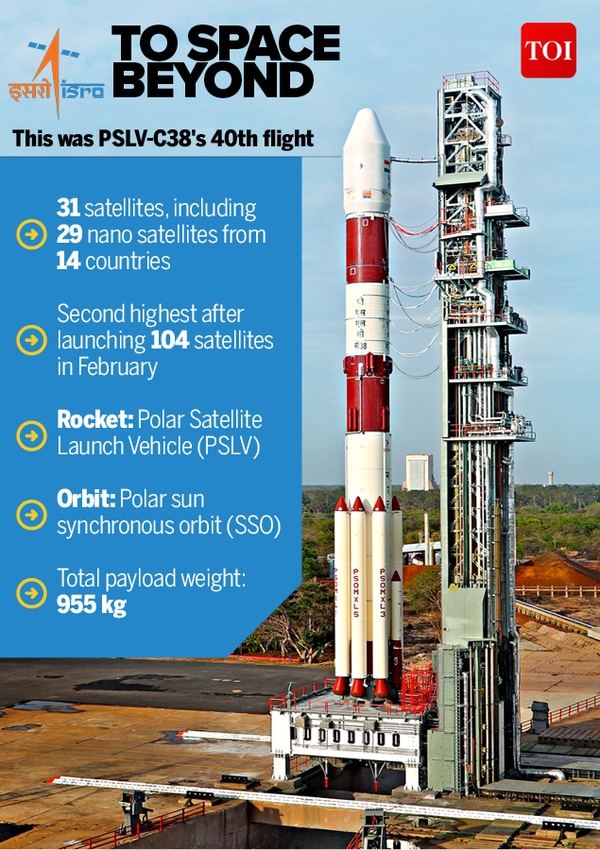- News
- India News
- Isro’s PSLV-C38 places Cartosat-2s and 30 nano satellites in orbit
Trending
This story is from June 23, 2017
Isro’s PSLV-C38 places Cartosat-2s and 30 nano satellites in orbit
PSLV-C38 blasted off from the first launch pad at Satish Dhawan Space Centre in Sriharikota at 9.29am. It was PSLV’s the 40th flight.

PSLV-C38 lifts off from Satish Dhawan Space Centre in Sriharikota on Friday (TOI photo by R Ramesh Shankar)
Key Highlights
- It was PSLV’s the 40th flight
- The main payload was the sixth satellite in the Cartosat-2 series
- Twenty nine of the 30 nano satellites were from 14 foreign countries
SRIHARIKOTA: Indian Space Research Organisation (Isro) once again displayed its mastery in launching multiple satellites in a single flight by placing 31 satellites in their orbits on Friday. A Polar Satellite Launch Vehicle -- PSLV-C38 – placed earth observation satellite Cartosat-2s and 30 nano satellites, including 29 from 14 different countries, in their respective orbits.
PSLV-C38 blasted off from the first launch pad at Satish Dhawan Space Centre in Sriharikota at 9.29am.It was PSLV’s the 40th flight.
Around 16 minutes after lift-off, the rocket placed its main payload –Cartosat-2 Series Satellite-- in orbit. The satellite is the sixth in the Cartosat-2 series.
As the rocket propelled further up the space, it ejected 30 other nano satellites. Twenty nine satellites belonged to 14 foreign countries -- Austria, Belgium, Chile, the Czech Republic, Finland, France, Germany, Italy, Japan, Latvia, Lithuania, Slovakia, the UK and the US.
The launch also marked the second highest number of payloads in a single flight after Isro launched 104 satellites onboard PSLV-C37 on February 15 this year.
Isro chairman A S Kiran Kumar congratulated the scientists after the mission was declared a success.
‘Not an ordinary mission’
Vikram Sarabhai Space Centre director K Sivan said it was not an ordinary mission. PS4 (fourth stage) would travel 10 more orbits after ejecting all the satellites, he said.
Mission director B Jayakumar said the vehicle had two more payloads apart from the 31 satellites. The two additional payloads would conduct certain experiments in 10 different orbits. However, he didn’t give details of the two additional payloads.
“The fourth stage of the vehicle will be reignited thrice. The atmospheric data collected from the orbit will be useful for future missions,” he said.
“The success of the mission shows that PSLV can do any mission, carry any number of satellites and travel multiple orbits,” Jayakumar said.
Satish Dhawan Space Centre director P Kunhikrishnan said, “The mission clearly demonstrates the reliability of the launch vehicle.”


Cartosat
The 712kg Cartosat will provide regular remote sensing services using its panchromatic and multispectral cameras.
The images sent by the satellite will be useful for cartographic applications, urban and rural applications, coastal land use and regulation, utility management like road network monitoring, water distribution, creation of land use maps, change detection to bring out geographical and man-made features and various other land information system (LIS) as well as geographical information system (GIS) applications.
India has one of the largest fleet of remote sensing satellites. While these satellites provide services for the public, they also have performed specific tasks in the past. It is to recall that images from one of the satellites, Cartosat-2C, was used to nail the targets during India’s surgical strikes on Pakistan last year.
Read this story in Bengali
Read this story in Kannada
Read this story in Marathi
PSLV-C38 blasted off from the first launch pad at Satish Dhawan Space Centre in Sriharikota at 9.29am.It was PSLV’s the 40th flight.
Around 16 minutes after lift-off, the rocket placed its main payload –Cartosat-2 Series Satellite-- in orbit. The satellite is the sixth in the Cartosat-2 series.
As the rocket propelled further up the space, it ejected 30 other nano satellites. Twenty nine satellites belonged to 14 foreign countries -- Austria, Belgium, Chile, the Czech Republic, Finland, France, Germany, Italy, Japan, Latvia, Lithuania, Slovakia, the UK and the US.
One nano satellite was made by students of Noorul Islam University in Kanyakumari district of Tamil Nadu.
The launch also marked the second highest number of payloads in a single flight after Isro launched 104 satellites onboard PSLV-C37 on February 15 this year.
Isro chairman A S Kiran Kumar congratulated the scientists after the mission was declared a success.
‘Not an ordinary mission’
Vikram Sarabhai Space Centre director K Sivan said it was not an ordinary mission. PS4 (fourth stage) would travel 10 more orbits after ejecting all the satellites, he said.
Mission director B Jayakumar said the vehicle had two more payloads apart from the 31 satellites. The two additional payloads would conduct certain experiments in 10 different orbits. However, he didn’t give details of the two additional payloads.
“The fourth stage of the vehicle will be reignited thrice. The atmospheric data collected from the orbit will be useful for future missions,” he said.
“The success of the mission shows that PSLV can do any mission, carry any number of satellites and travel multiple orbits,” Jayakumar said.
Satish Dhawan Space Centre director P Kunhikrishnan said, “The mission clearly demonstrates the reliability of the launch vehicle.”


Cartosat
The 712kg Cartosat will provide regular remote sensing services using its panchromatic and multispectral cameras.
The images sent by the satellite will be useful for cartographic applications, urban and rural applications, coastal land use and regulation, utility management like road network monitoring, water distribution, creation of land use maps, change detection to bring out geographical and man-made features and various other land information system (LIS) as well as geographical information system (GIS) applications.
India has one of the largest fleet of remote sensing satellites. While these satellites provide services for the public, they also have performed specific tasks in the past. It is to recall that images from one of the satellites, Cartosat-2C, was used to nail the targets during India’s surgical strikes on Pakistan last year.
Read this story in Bengali
Read this story in Kannada
Read this story in Marathi
End of Article
FOLLOW US ON SOCIAL MEDIA










